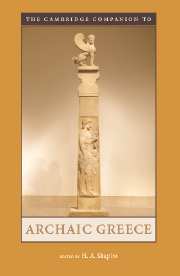4 - The Life Cycle in Archaic Greece
from Part 1 - History of Archaic Greece
Published online by Cambridge University Press: 28 November 2009
Summary
Arnold van Gennep's The Rites of Passage (1909; English trans. 1960) has had a profound impact on how we understand the nature of the “life cycle” and its rites de passage - each of which consists (to varying extents) of stages of separation, transition, and (re)incorporation. The life cycle, particularly in a community-oriented culture such as Archaic Greece, cannot be examined merely at the level of the individual; it must also be considered from the perspective of the individual vis-à-vis both household and society. In this chapter, I will examine the Archaic Greek rites of birth, initiation, marriage, and death in light of van Gennep's schema and attempt to ascertain the ways in which the Greeks negotiated these potentially anxiety-producing passages. Rites of passage are considerably better attested in the Classical period than in the Archaic, but the fragments available to us - literary, archaeological, and iconographic - allow us to see that many of the “Classical” life-cycle rituals are in fact rooted in Archaic practice. / Stages of Life / Before we address the specifics of the Archaic Greek rites of passage, we should examine the ways in which the life cycle was divided. Not surprisingly, there were a number of ways to classify the stages of life.
- Type
- Chapter
- Information
- The Cambridge Companion to Archaic Greece , pp. 85 - 108Publisher: Cambridge University PressPrint publication year: 2007
- 5
- Cited by

